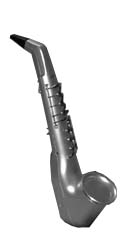
Casio DH-100 (and DH-200) Wind Synth Review
The first impressions review is below. First, here's a general overview:
Casio used to make a beginner wind controller called
the DH-100 (silver) and DH-200 (black). Casio also build
some others (DH-500, DH-800) that were available in Japan.
These were inexpensive, all plastic wind controllers that
looked like a plastic saxophone. With a built in tone generator
that sounded like a child's toy, the DH-100 did put out a
controllable midi stream that could drive any midi synths.
The keys are lightweight and click a lot, there is no reed
bender or other controllers on the instrument. This is only
a beginner's instrument. Yes, it is a wind synth, but it's
not even close to the offerings from Yamaha or Akai. While
some people do gig with the DH, it's not considered a professional
instrument.
First Impressions Review of the Casio DH-100/DH-200
Author: Art Whitfield
My very first wind synth was the Casio DH-200. The only difference between the DH-100 and DH-200 is that the -100 is silver (most common) and the -200 is black. I always prefer black. The synth came in a typical brightly colored consumer box with a picture of a kid playing the instrument. Hmmm, there's a clue as to the market - kids. Opening it up you find the instrument looking like a plastic soprano sax, except I was pleasantly surprised to find there were metal keys. And they felt pretty nice in my hands. So far, so good! There was a neckstrap (pretty lame style), and a spare mouthpiece in the box too. But no wall-wart (AC-adapter), so it is batteries for starters. The wind synth takes five (5) AA batteries. So I put in batteries, switched on the power, adjusted the little volume control, then blew into the mouthpiece. Sound - music actually. As a sax player, I found the instrument very easy to play. There are actually 6 total sounds in the instrument (sax, trumpet, synth-reed, oboe, clarinet, and flute). Don't let the names fool you. They all sound like 1980's style synthesizer, and rather toy like. The "sax" sound was one of the best, but that's relative to the others. I really want to call it lame, although it had a decent vibrato built in. There's a headphone jack available too, so you can play your music privately instead of having the sound come out of the speaker in the bell of the instrument.
The interesting thing is that I found the DH-100/200 was fun to play. This was my first wind synth experience, and while its clearly more of a curiosity than a professional instrument, it's not a kiddie toy. It's more fun and musical than a kiddie toy. The volume response nicely responds to breath pressure, and the keyworks feel pretty good to a sax player like me, although a bit loose and it rattles on the key pivots. The left hand pinky finger G# key is where you expect it, as is low C on the right hand pinky finger. But there's no side Bb. I really missed that. But you can use the F key to flat the B like a flute. On the top of the keyworks is a key that activates a portamento feature (pitch slide from note to note). Certainly not like professional synth's portamento, but a darned lot of fun to play with. There's the "fun" word again.
The instrument has a MIDI out, so of course I immediately hooked it up to an old synth that I had in the house at the time. The MIDI data stream is not CC02, but instead AFTOUCH. As with any wind controller, and MIDI connected synth will need some voice programming to respond well. And since the DH-100/200 is mostly a novice instrument, it is unlikely the MIDI will be used for much more than "making the keyboard make noises" such as piano, percussion, and just goofing around.
As my first wind synth, I was having musical fun immediately. The instrument was inexpensive, and as such my expectations were pretty low. Out of the box, it was fun to play, and I kept the first DH-200 for several years even after owning other wind controllers. The Casio DH-100/200 is not a players instrument. It won't replace a Yamaha WX or an Akai EWI wind controller at all. But if you happen upon one for a good price, they are fun.
Postscript: I've now been playing wind controller for 12+ years now, with my main instrument being a WX7 and several different synth modules. Yet about 5 years ago I bought another DH-200 just to keep it around the house. It mostly sits there as a reminder of how I started on this journey into wind synth playing. But I'm darned glad to have the DH-200 back in my collection.